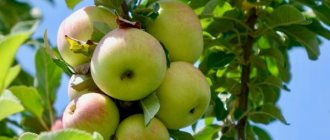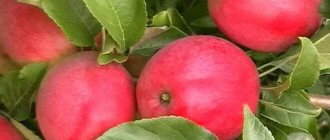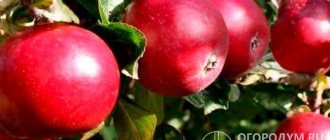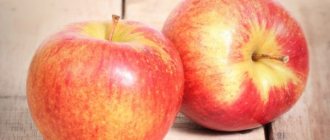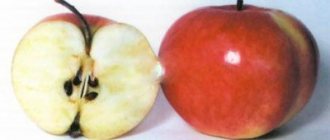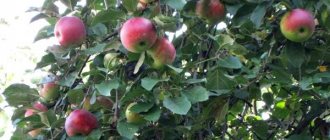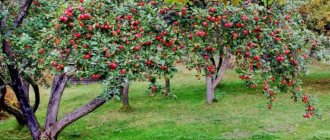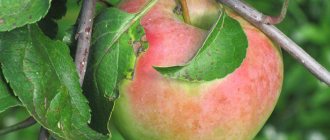Just a couple of centuries ago it was impossible to imagine a single garden without beauties of this variety. Anises were rightfully considered the kings of apple trees. Their delicious juicy fruits decorated princely tables and were served for dessert as an exquisite and healthy delicacy. They were dried, pastilles were made from them, jams and jams were made, fragrant apple pies and strudels were baked.
Anise is no less popular now, and is not losing its position to fashionable Fuji, Jonathan, and Red Gold. This variety has its own secrets that have helped it occupy the main place in the garden for a long time.
Description and characteristics of the apple tree Anise
The apple variety Anis is an autumn apple variety. Some time ago they were popular along with Antonovka and other modern varieties. The tree has a spreading pyramidal crown, often dense in the middle. The apple tree grows tall, spreading, and takes up a lot of space in the garden. This must be taken into account when planting Anise on the site.
The apples grow large, with yellow skin and reddish stripes. The weight reaches 300 g, but with age they begin to become smaller. The pulp is creamy, juicy, slightly grainy, sweet, brightly aromatic and slightly sour. The fruits contain a lot of ascorbic acid. Despite their sweet taste, apples are low in calories and are therefore recommended during a diet.
What is the height of the apple tree
The tree grows tall with a spreading, wide crown. The apple tree grows more than 5-6 m. Plus it gives a lot of shade, so it is better to plant it in that corner of the garden from which it will not shade the entire area. It is also necessary to calculate the territory of the tree trunk circle.
How long does an apple tree live?
With proper care, Anise can live for almost 20 years or even more. Moreover, at 30 years old you can collect more than 300 kg from a tree, but every year the crown thickens more and the fruits become smaller. Therefore, constant rejuvenation of the tree is necessary.
There is information about record Anise apple trees, which are already about 100 years old. This is quite possible.
How long does it take for an apple tree to bear fruit?
The variety begins to bear fruit 4-5 years after planting. The harvest is harvested from three-year-old branches. The tree bears fruit for a very long time. Up to 200-250 kg of crop is harvested from one apple tree.
How long does an apple tree bloom?
Flowering begins in late spring - in May, but also depends on the weather. The apple tree blooms very beautifully. The flowers have a pale pink tint and a greenish tint. After flowering ends, fruits weighing no more than 100 g are formed. Typically, apples reach a size of 60-80 g.
The best pollinators for the Anise variety
Anise itself is an excellent pollinator. This variety is a good neighbor. For a rich harvest, pollinators such as Yandykovskaya, Bellefleur-Chinese, July Chernenko, and Borovinka are suitable for him. Also, don’t forget about Antonovka and Korichnevoe (Cinnamon) striped.
Ripening time
Anise can be harvested in the fall - in September. The remaining apples may still ripen in early October. The exact timing depends on the variety of Anise. The general ripening period is from the end of August to the first days of October. Apples keep well. After ripening they do not fall off the tree.
Productivity
This is a high-yielding variety. From one mature tree you can collect up to 300 kg of apples. Even by the standards of other trees, from old apple trees (20-30 years old) you can get a bountiful harvest of up to 300-320 kg. Although on average it turns out to be about 80-100 kg. But Anise has a property - the higher the yield, the more prone the tree is to periodicity. That is, if in the previous year there were a lot of apples, then the next year it can rest from fruiting.
Frost resistance
The variety also has excellent resistance to low temperatures. The apple variety Anis survives frosts well down to -40 degrees. Even if a tree is damaged during winter, it is quickly and easily restored.
Resistance to major diseases
But Anise cannot boast of resistance and immunity to diseases. They often suffer from black cancer, powdery mildew, scab and other ailments. May be attacked by pests. Therefore, it is necessary to carry out careful prevention and, if signs are detected, begin treatment immediately.
Harvest storage
Apples store well, especially if picked unripe. They can stay until March. It all depends on the variety and time of ripening. The later the apples ripen, the longer they last.
Pay attention to:
Apple tree gift to Grafsky
Apple tree variety Welsey
Apples Streifling
Description
Anises have long appeared in the gardens of the Volga region and have always been one of the most favorite varieties of apples. In terms of their popularity and fame, they were not inferior to Antonovka. And their fruits were consumed in huge quantities in industrial zones. In Michurin's works they were given the leading direction. This huge family of clones shares many common properties.
The young apple tree has a wide pyramidal crown, thickened in the middle. Having reached a period of maturity, it acquires a more spherical shape.
The leaves are slightly curved, with jagged edges. They have rich color and glossy shine. The bark of the trees is light brown. The trees themselves are tall and tall. The shoots are characterized by weak leaf cover. Fruiting occurs starting from 4-5 years of age, on three-year-old branches. Mainly on spears and ringlets, the yield is annual.
Fruiting continues for quite a long time. At full bloom, the total weight of apples can be 300 kg or more. As apple trees age, the fruits become smaller.
Popular varieties of Anise
Anise varieties have several varieties. They differ in appearance and timing of ripening and flowering.
Apple tree Anis Sverdlovsky
Trees of this variety are distinguished by their small height and oval crown. Already from the name it becomes clear that apple trees grow well in the conditions of the Urals. They have good resistance to low temperatures, as well as unpretentiousness.
Sverdlovsk apples are stored for a long time and can withstand transportation without losing their taste and aesthetic qualities. On average they grow to 100-120 g.
However, this variety of apple is highly susceptible to scab.
Scarlet Anise
This type of Anise is grown in the north and east of the Volga region. It is excellent for developing new varieties.
The advantages of the variety are its unpretentiousness and undemandingness to soils, care, and growing conditions. Scarlet Anise thrives in the northern and southern regions, as well as in mountainous areas.
Apples have a bright dark red blush.
Apple variety Anis Striped
The fruits are a little larger than those of Aloe. They are round and slightly flattened in shape. The peel is green-gray with a striped reddish blush.
The pulp tastes sweet, slightly sour, juicy. The apples are fragrant.
Harvest at the end of September.
The main feature of the variety is its high resistance to winter frosts, as well as fungal diseases. But the tree grows very tall.
Anise purple
The apples received this name due to the bright purple color of the peel. They grow large, sweet and very attractive in appearance. The pulp is juicy and aromatic.
The purple Anise variety of apples is well stored and transported.
Anise pink
The variety has all the same characteristics as the other representatives. Only the peel is yellow with pink stripes. The variety has good resistance to frost, but is weak to diseases and pests.
Reviews
- Evgeniy : “Relatives from Siberia praise it, since only Anis can survive in frosty winters.”
- Petrovich : “The fruits are very tasty.”
- Inna : “I received the Scarlet hybrid as a gift, and in the 4th year I collected the first harvest. I like the winter preparations made from it.”
- Dan : “I like varieties with sourness - Polosaty, Sverdlovsky. I harvest a great harvest and make delicious jam from apples.”
- Tamara : “Apple trees winter well, the fruits are delicious. The only negative is the trees’ susceptibility to scab.”
Read about other popular varieties of apples – “Antonovka”, “Borovinka”, “Kitayka”, “Melba”, Cinnamon-striped in the materials at the links.
Advantages and disadvantages
It’s not for nothing that gardeners love anise. It has many advantages that outweigh the disadvantages. Advantages of the Anise variety:
- high frost resistance;
- endurance and unpretentiousness to natural growing conditions, soils and care;
- excellent decorative qualities of trees;
- good acclimatization;
- application for breeding new varieties;
- taste, aroma, pleasant taste and beautiful appearance;
- lifespan of trees;
- transportability and storage of fruits;
- abundant and regular harvest;
- do not fall off after ripening, you can pick everything together after full ripening;
- average resistance to scab and fungi.
Among the disadvantages are:
- if stored improperly, it can cause rot;
- apples can grow in different sizes;
- high incidence of black cancer and powdery mildew;
- old trees can begin to bear fruit once every 2 years;
- self-sterility and the need to plant pollinators.
Knowing about the disadvantages of a variety, it is easier to prevent and minimize them. Prevention, such as regular pruning, will help avoid disease and increase yield.
Growing in regions
The hardiness of the apple tree allows it to be grown almost anywhere, but there are some restrictions depending on the region.
In outskirts of Moscow
The Moscow region is a very suitable place for growing representatives of Anise, and more specifically Sverdlovsk. However, resistance to scab and powdery mildew leaves much to be desired. Protection against fungus will need to be given special attention.
In the Urals and Siberia
Anise Sverdlovsk is one of the most popular varieties in these regions, because this is its homeland. No wonder, because it was there that it was created and fully reveals the fullness of its amazing taste and aroma.
In Altai
Theoretically, all the characteristics of Altai are quite suitable for growing Sverdlovsk Anise. Or it would be more correct to point out that the variety’s high resistance to cold and external influences allows it to survive the climate of the Altai region. But he is not found here, at least not in official sources of information.
Reviews from gardeners about the Anise variety
The fruit variety is very popular among gardeners, especially the striped one. The main qualities are frost resistance and abundant fruiting.
Vladimir, Ekaterinburg
My grandmother also had a huge apple tree. The apples were red, bright and very tasty. The aroma filled the entire garden. Now I have it myself. Excellent fresh and for processing.
Anna Vladimirovna, Minsk
If you have Anise in your garden, Sverdlovsk is better. It is unpretentious, frost-resistant, and the apples are aromatic, juicy and sweet. Plus, the tree grows compactly, compared to other species of this variety. And there’s less fussing with scab; it doesn’t affect the apple tree.
Mikhail, Novosibirsk
Not much grows in our area, so Anise is perfect. They grow Sverdlovsk and really like it in appearance and taste. I recommend to everyone.
Features of fruiting
The tree is medium-sized, up to 3-3.5 meters high (depending on the rootstock), with a fairly compact rounded crown, which, growing with age, becomes wide-pyramidal. Skeletal branches extend from the trunk at an angle of about 55-60°, the shoots are straight, of medium thickness, round in cross-section, brown in color, heavily pubescent. The leaves are small, green, round, with jagged (crenate-serrate) edges, short petioles and small saber-shaped stipules.
Apple trees are quite compact - medium-sized, with an oval (ovoid) crown formed from skeletal branches that extend from the trunk at an acute angle
Fruiting is of mixed type: the main crop is formed on ringlets, densely located on branches over 2 years old, and on last year's growths.
Early fruiting is high - trees begin to bear fruit in the 3-4th year after budding. Maximum output is observed in plants from 5-7 years old; the active period lasts for a long time, while fruiting is stable and regular (without an “alternation effect” over the years).
Flowering dates occur at the end of May - beginning of June. The trees bloom profusely and amicably for about 10 days. The buds are pink, the open flowers are white with a slight pinkish tint, medium-sized, saucer-shaped. The column of pistils is short, pubescent, the stigmas of the pistils are located slightly below the level of the anthers.
The plant is self-sterile and for the formation of ovaries it requires pollinating apple trees that bloom in the Middle Urals during a similar period, for example, “Borovinka”, “Belfleur-Chinese”, “Yandykovskoe”, “Iyulskoe Chernenko”, “Antonovka”.
Blooming "Antonovka" (pictured) promotes intensive pollination of "Anise Sverdlovsk" and fruit set
According to gardeners, one of the disadvantages of the variety is the falling off of the bulk of the flowers and primary ovaries, of which only about 10% develop into full-fledged fruits. Productivity indicators are assessed as average - in favorable years, an adult tree produces up to 70-75 kg of apples. According to the originator's data obtained over 5 years of field testing, annual yields are about 120 c/ha.
The main value of the variety lies in the apples, which have almost the same size (medium-sized, fruit weight on average 90-120 g) and an even, regular shape (round and oval, slightly flattened) with weak ribbing.
The fruits have a very attractive appearance, pleasant taste and delicate aroma.
The skin of apples is dry and smooth, shiny, covered with a natural waxy coating. The main color is light yellow, the integumentary color is in the form of a blurred bright red (crimson) blush on almost the entire surface or most of the fruit. The peduncle is short. The funnel is small, conical, almost free of rust.
| Nutrients and beneficial substances | Quantity per 100 g of product |
| Vitamin C (ascorbic acid) | 14.4 mg (up to 22.5) |
| Sahara | 13.5 g |
| Acids | 0.83 g |
| P-active substances (total) | 234.8 mg (up to 409.9) |
We invite you to read: Bacterial burn of an apple tree - symptoms, methods of combating a harmful infection, treatment and preventive measures
Apples are good both for fresh consumption and for all processing methods. They make especially tasty drinks (juice and cider), as well as jam, marmalade, and marshmallows.
Juicy and sweet fruits are used to make excellent juices, cider, and apple cider vinegar.
Anise apple processing products are in great consumer demand, therefore, despite the low shelf life of the fruit, this variety is grown on an industrial scale, and it is also very popular among amateur gardeners.
Apples ripen quickly in mid-late September. Fruits at the stage of technical ripeness do not fall off; they are picked almost simultaneously, usually in the first ten days of October. The harvested crop tolerates transportation well, but has a short shelf life. The consumer period begins immediately after picking and lasts about 2 months, until December.
Apples stick well to trees without falling off before harvest time. They have a round shape and a ribbed surface. The color palette in which the fruits are painted can be very diverse: yellow, pink, red, greenish.
Colors and shades can be combined in the most amazing ways. Ripe fruits have a pretty reddish tint. A whitish coating beautifully envelops the glossy surface. Scarlet inclusions shine through the thin skin.
What is characteristic of Anise apples:
- good shelf life (up to 30 days in the pantry, and even longer in refrigeration devices);
- marketability estimated at 80%;
- availability of premium grade fruits 35%.
Anise apples are very tasty. The pulp is juicy, white in color with a barely noticeable tint of greenish tone. It is not difficult even for a beginner to distinguish them from other varieties. They have characteristic features:
- scarlet blush on most of the fruit;
- yellow-green color;
- slightly rough skin;
- juicy pulp, white or slightly creamy;
- sweet and sour taste;
- pronounced apple aroma.
Flowering occurs with white-pink buds, the shape of which is cup-shaped and medium in size.
Planting a variety
Since Anise grows as a tall and spreading tree, it requires a lot of light and space. Choose a place that is protected from drafts but well ventilated. This will help avoid fungal infection.
It is advisable to choose light, neutral soils that allow air and moisture to pass through well, without waterlogging.
It is better to plant trees in the spring so that the seedlings have time to adapt. This is especially true for the central and northern regions. Prepare the planting hole in advance - in the fall. Fill it with drainage, fertile light soil and fertilizers.
When planting, observe the following few nuances:
- the root collar should rise above the ground by 5-10 cm;
- tie the seedling to a stake so that it grows vertically upward;
- To stimulate root growth and survival, place the plant in warm, settled water for a couple of days.
When allocating space on the site, leave enough space for the tree trunk circle. The tree will grow tall and provide great shade. Pollinators should also be planted nearby. The distance between crops should be at least 5 m.
Useful:
How to choose and plant an apple tree seedling correctly.
Diseases and pests
Apple tree fruits Anis Scarlet: photo of the variety
Despite the fact that this plant is very well protected from all kinds of diseases by its powerful immune system, it can still get sick: no one is immune from this.
However, there are no diseases unique to this variety. He suffers from the same ailments as all other apple crops. Among them are:
- Powdery mildew is a rather unpleasant disease, which is expressed in the form of a white coating that affects the young vegetative parts of the plant: leaves, shoots and flowers.
If the disease is not stopped in time, it can lead to complete drying out of the affected parts.
In order to prevent infection with this disease, as well as to cope with it if it has already occurred, it is necessary to use one of the following drugs: Skor or Topaz.
- Scab is an equally unpleasant fungal disease that occurs only if the air maintains a very high humidity level for a long time.
It affects absolutely all parts of the plant: from the leaves to the fruits themselves, which leads to the appearance of brown spots on them and to further decay.
In order to overcome this disease, drugs such as urea solution or copper chloroxide are used.
Rules of care
Standard care includes regular watering and fertilizing, collecting fallen leaves and fruits, loosening, and pruning.
Fertilizing varieties
Anises respond positively to timely feeding. Apply phosphorus, potassium fertilizers and organic matter:
- superphosphates, urea, potassium chloride;
- wood ash;
- nitroammophoska;
- complex fertilizers with micro- and macroelements.
Be sure to follow the instructions. Phosphorus fertilizers are needed during planting and in the spring, when the plant is actively growing. In summer, add potash to improve the quantity and quality of the harvest.
Watering Apple Trees Anise
It is also necessary to water Anise regularly and abundantly. You can install irrigation systems in the tree trunk circle. Water with warm, settled water.
Abundant watering is required:
- during spring growing season;
- a couple of weeks before flowering;
- during fruit filling;
- in autumn 4 weeks before frost.
One apple tree should require about 10 buckets of water.
You need to adjust the watering level depending on the weather. If it is rainy and cool, then reduce the volume, and in case of extreme heat and drought, increase it.
Disease Prevention
To prevent fungi and pests from infesting, be sure to regularly loosen the soil in the tree trunk circle. It is also useful to mulch the earth with straw, peat, non-woven material, pine needles or sawdust. Previously, we published material about apple tree pests with photographs, we recommend that you familiarize yourself with them.
Trimming and shaping
Pay special attention to pruning and crown shaping. Anises grow very tall and bushy. Because of this, fungi and parasites develop inside. Plus, it is difficult to harvest crops from a great height. As a preventative measure, carry out sanitary pruning in spring and autumn. Remove dry and damaged, diseased and infected branches, those that grow in the wrong direction.
To prevent the tree from growing too tall, pinch it back in the spring after planting. Also, as it grows, the crown is formed as follows:
- cup-shaped;
- bushy;
- oval;
- longline.
Be sure to remove shoots growing at an acute angle to the trunk and inside the crown. It is also advisable to pinch out the side shoots. Before work, be sure to look at the information about when and how to properly prune an apple tree.
Preparing for winter
Prepare before winter. The trunk needs to be whitened, wrapped in burlap and spruce branches. And in winter, it is necessary to strengthen the snow cover of the tree, especially young seedlings. In order not to miss anything important, we recommend that you familiarize yourself with the rules for caring for an apple tree by month.
How to choose the right seedling?
What to look for when buying planting material? This question is often asked by many gardeners planning to plant a garden. Main nuances when choosing:
- The optimal age for planting a seedling is 1-2 years.
- The ground part may be without branches in 1-year-old specimens or may have 2-3 branches.
- 2-year-old seedlings should already have 4-5 shoots.
- The kidneys may be swollen, but in no case open. The more visible the leaf blade is, the worse the tree will take root.
- Well-developed roots are a good guarantee of survival. If they are dry or poorly developed, it is better to postpone the purchase.
- The graft is located 7-8 cm above the root.
- A healthy bark should not show signs of damage: cracks, erosions, ulcers, peelings.
- The best height is 1.5 m.
No matter how tempted you are by the price, or the opportunity to purchase a seedling close to home. It is better to trust a trusted nursery than a random seller.
Do not forget to follow the basic rules for caring for apple trees:
- feeding;
- trimmings;
- pest control;
- disease prevention.
And then Anise will certainly be a good choice for your garden. Its tasty and healthy fruits will contribute to your health.
Harvest and storage
The plant begins to bear fruit 5 years after planting.
The apples ripen almost simultaneously, but do not fall to the ground. Harvest in mid-September in dry and warm weather. They cannot be wiped or processed so as not to damage the wax layer. It protects them during storage and prevents the peel from drying out.
Fruits are stored in a cool place with average humidity in wooden boxes. Be sure to line the layers with parchment paper and onion skins. The later the fruits ripen, the better they are stored. Can remain for 2-3 months.
Video: How to properly harvest and store apples for the winter
Subspecies and options
Gardeners of the North, Far East, Siberia and the Urals grow this tree in a creeping form.
There are several options for creating such a crown:
- flat spindle;
- melon slate;
- Krasnoyarsk double-shouldered stone;
- Minusinsk half-stlane.
The main advantages of such trees are that they are easier to cover for the winter, and harvesting with a compact crown is also easier.
Common apple tree Anis Sverdlovsky (malus)

